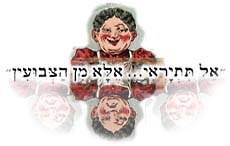|

This verse, from the Song of Deborah the Prophet, is the only one in the Bible
which uses the common Hebrew word,  (zeva), for color. The
(zeva), for color. The  (ketonet pasim) worn by Joseph, popularly known as the "coat of
many colors," is probably more accurately translated "ornamented tunic"
or "a robe with sleeves."[1]
Related to the Aramaic ziv'a and the Arabic zib'eh, the Hebrew
word for color is
(ketonet pasim) worn by Joseph, popularly known as the "coat of
many colors," is probably more accurately translated "ornamented tunic"
or "a robe with sleeves."[1]
Related to the Aramaic ziv'a and the Arabic zib'eh, the Hebrew
word for color is  (zeva); its rootword is
(zeva); its rootword is  (z-v-a).
(z-v-a).
In modern Hebrew
a tulip, which comes in many colors although deep red seems to have been most
prolific before the age of botanical engineering, is known as  (ziv'oni) (lit., colorful). Anything colorful —
food, clothing or the marketplace — is referred to
as
(ziv'oni) (lit., colorful). Anything colorful —
food, clothing or the marketplace — is referred to
as  (ziv'oni). A house painter is known as a
(ziv'oni). A house painter is known as a  (zaba), and his painting trade is known as
(zaba), and his painting trade is known as  (zaba'ut). Paint, of course, is
(zaba'ut). Paint, of course, is  (zeva), while the pigment that gives plants and animals their hue is
(zeva), while the pigment that gives plants and animals their hue is
 (ziv'an).
(ziv'an).

A most interesting
derivative of the  (z-v-a) rootword is the word for hypocrisy,
(z-v-a) rootword is the word for hypocrisy,  (zevi'ut). The word
(zevi'ut). The word  (zavu'a) literally means colored or painted, and so one who hides his
true thoughts and intentions and presents himself in "different colors"
is also referred to as
(zavu'a) literally means colored or painted, and so one who hides his
true thoughts and intentions and presents himself in "different colors"
is also referred to as  (zavua), a hypocrite.
(zavua), a hypocrite.
An alternative
Hebrew word for  (zeva) is
(zeva) is  (gaven), hue — with its derivative meaning
- variation. When a classroom lesson starts to get boring, the teacher might
suggest,
(gaven), hue — with its derivative meaning
- variation. When a classroom lesson starts to get boring, the teacher might
suggest,  (bo'u negaven), let's add variation [i.e., color] to the lesson, perhaps
by playing a game or putting on a skit. Or at a theatrical performance which
incorporates song, dance and poetry, we might express our satisfaction with
the
(bo'u negaven), let's add variation [i.e., color] to the lesson, perhaps
by playing a game or putting on a skit. Or at a theatrical performance which
incorporates song, dance and poetry, we might express our satisfaction with
the (givvun), the variation, in the program. We enrich the fabric of our
lives when we follow the advice of the great Hebrew writer Hayyim Nahman Bialik:
"Then many colors [hues], new colors, shall you adjoin to the light in
your life."[2]
(givvun), the variation, in the program. We enrich the fabric of our
lives when we follow the advice of the great Hebrew writer Hayyim Nahman Bialik:
"Then many colors [hues], new colors, shall you adjoin to the light in
your life."[2]
![Then many colors [hues], new colors, shall you adjoin to the many colors [hues], new colors](images/editor_ill.jpg)
COLOR Table of Contents
|